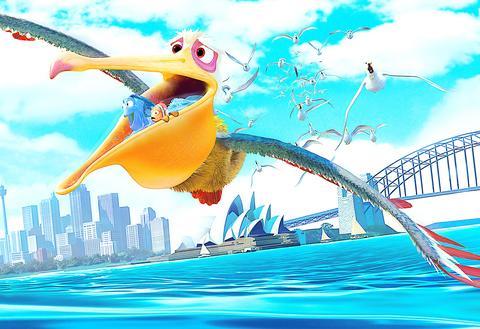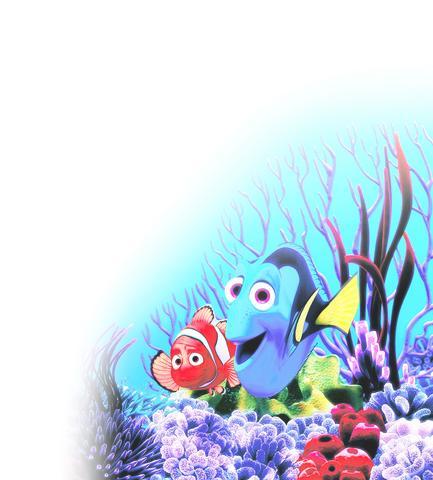Among the finned creatures who wriggle and dart through Disney/Pixar's sparkling aquatic fable, Finding Nemo, the most comically inspired is a great white shark named Bruce (the voice of Barry Humphries), who glides through the ocean flanked by two menacing sidekicks, Anchor (Eric Bana), a hammerhead, and Chum (Bruce Spence), a mako. An ominous hulk, with eyes like gleaming bullets and a savage jack-o'-lantern grin, Bruce has adopted a 12-step program to curb his insatiable appetite for other fish. "Fish are friends, not food," goes the mantra he repeats in an unctuously imperious drawl whenever he's tempted to gobble up a passing morsel.
But sharks will be sharks, and Bruce's resolution is awfully shaky. In the movie's scariest scene, the drifting scent of blood drives him into a ravenous frenzy in which his eyes turn black and he lunges after Marlin (Albert Brooks), the meek little orange-and-white clown fish he has been regaling with his recovery spiel. Their hair-raising life-or-death chase takes them around a sunken submarine and through a minefield.
Bruce is only the most fearsome of the predators encountered by Marlin, a nervous, overprotective father who sets out over the great, wide ocean to find his lost son Nemo (Alexander Gould). Before his journey is over, he finds himself trapped in the mouth of a blue whale with only moments to spare before it takes a big, lethal gulp, and pursued by a flock of sea gulls that are almost as menacing as the birds in Alfred Hitchcock's avian nightmare.

PHOTOS: BVI
Nemo, a squeaky-voiced youngster who was born with one fin smaller than the other, disappears on his first day of school after defying his father with a daredevil stunt. Leaving the security of the Great Barrier Reef where he and his dad live comfortably inside a sea anemone, he swims out to inspect a distant boat and is scooped up in a scuba diver's net.
Although Marlin swims to the rescue, he is repelled by the blast of the boat's propeller. The boy eventually lands inside the aquarium of a dentist in Sydney, Australia, where his tank companions are so bored they have picked up the technical argot of dentistry from observing their keeper. In setting out to find Nemo, Marlin has only a single clue as to his whereabouts: the address of the fishing boat.
In its broadest outlines, Finding Nemo is an upbeat, sentimental fable about a fearful father and a rebellious son who recklessly breaks away. Each has to learn to trust and respect the other, but to arrive at a better understanding both must endure any number of harrowing trials.

At home, Marlin, a well-meaning worrywart, addresses his son in the nagging whine of a nervous milquetoast. Initially he seems the least likely candidate to risk his life to save anyone. But once he takes to the open water, he is unstoppably courageous and resourceful in his quest to find the boy.
Along the way he teams up with Dory (Ellen DeGeneres), an inveterately cheery blue tang with a severe case of short-term memory loss that causes many complications. The character, who speaks in daffy non sequiturs but knows enough to tutor Marlin in the funny language of whales, is the movie's comic center. And DeGeneres infuses what could have been a one-note role with an irresistible enthusiasm and playfulness.
The adventures they share include near-entrapment in a school of deadly jellyfish and a joy ride on the East Australian Current with a green sea turtle named Crush (Andrew Stanton) who, despite being 150 years old, has the adventurous spirit and vocabulary of a 16-year-old surfer dude.
High on the movie's list of accomplishments is its creation of an undersea wonderland whose opalescent colors and shifting light reflect the enchanted aura of dreamy aquatic photography. Whether the setting is a fish tank or an ocean current, the movie successfully sustains a watery ambience, not an easy thing to do given water's semitransparency.
Finding Nemo doesn't pretend that its undersea environment is a happier alternative to the world above. Under its comforting narrative arc, it presents a stark vision of the sea world as a treacherous jungle that, for all its beauty and excitement, is an extremely dangerous place to live. The movie jumps right into the darker side of life in a scene in which Marlin and his wife, Coral (Elizabeth Perkins), marvel at the more than 400 eggs that are about to yield a brood of children, only to have their future snatched away with the unwelcome appearance of a barracuda. In one furious snap, the intruder devours Coral and all but one of the eggs, leaving only Marlin and the single egg that becomes Nemo.
Once Nemo has landed in the aquarium, the story cuts back and forth between the father, desperately searching for his son, and Nemo making friends with his tankmates and plotting an improbable escape. The tank's unofficial leader, Gill (Willem Dafoe), is a black-and-white-striped Moorish idol, who like Nemo is a former ocean dweller longing to return to the sea.
The escape plan becomes a race against time once Nemo learns he is to be given as a present to the dentist's 8-year-old niece, Darla, a savage little monster who has been known to take a baggie containing a fish and shake it violently. Darla's appearances are accompanied by snippets of the shrieking murder music from Psycho.
Visual imagination and sophisticated wit raise Finding Nemo to a level just below the peaks of Pixar's Toy Story movies and Monsters, Inc, which were created by many of the same hands. As in the earlier Pixar movies, the animation achieves an astonishing synergy of voice, computer-animated image and dialogue. Facial expressions match vocal inflections with a precision that lends even the minor characters an almost surreal clarity.
The humor bubbling through Finding Nemo is so fresh, sure of itself and devoid of the cutesy, saccharine condescension that drips through so many family comedies that you have to wonder what it is about the Pixar technology that inspires the creators to be so endlessly inventive. The capacity of computer-animation to evoke a three-dimensional sense of detail obviously has something to do with it. But the enterprise still wouldn't amount to much without the formidable storytelling talents driving it.

May 11 to May 18 The original Taichung Railway Station was long thought to have been completely razed. Opening on May 15, 1905, the one-story wooden structure soon outgrew its purpose and was replaced in 1917 by a grandiose, Western-style station. During construction on the third-generation station in 2017, workers discovered the service pit for the original station’s locomotive depot. A year later, a small wooden building on site was determined by historians to be the first stationmaster’s office, built around 1908. With these findings, the Taichung Railway Station Cultural Park now boasts that it has

Wooden houses wedged between concrete, crumbling brick facades with roofs gaping to the sky, and tiled art deco buildings down narrow alleyways: Taichung Central District’s (中區) aging architecture reveals both the allure and reality of the old downtown. From Indigenous settlement to capital under Qing Dynasty rule through to Japanese colonization, Taichung’s Central District holds a long and layered history. The bygone beauty of its streets once earned it the nickname “Little Kyoto.” Since the late eighties, however, the shifting of economic and government centers westward signaled a gradual decline in the area’s evolving fortunes. With the regeneration of the once

In February of this year the Taipei Times reported on the visit of Lienchiang County Commissioner Wang Chung-ming (王忠銘) of the Chinese Nationalist Party (KMT) and a delegation to a lantern festival in Fuzhou’s Mawei District in Fujian Province. “Today, Mawei and Matsu jointly marked the lantern festival,” Wang was quoted as saying, adding that both sides “being of one people,” is a cause for joy. Wang was passing around a common claim of officials of the People’s Republic of China (PRC) and the PRC’s allies and supporters in Taiwan — KMT and the Taiwan People’s Party — and elsewhere: Taiwan and

Even by the standards of Ukraine’s International Legion, which comprises volunteers from over 55 countries, Han has an unusual backstory. Born in Taichung, he grew up in Costa Rica — then one of Taiwan’s diplomatic allies — where a relative worked for the embassy. After attending an American international high school in San Jose, Costa Rica’s capital, Han — who prefers to use only his given name for OPSEC (operations security) reasons — moved to the US in his teens. He attended Penn State University before returning to Taiwan to work in the semiconductor industry in Kaohsiung, where he